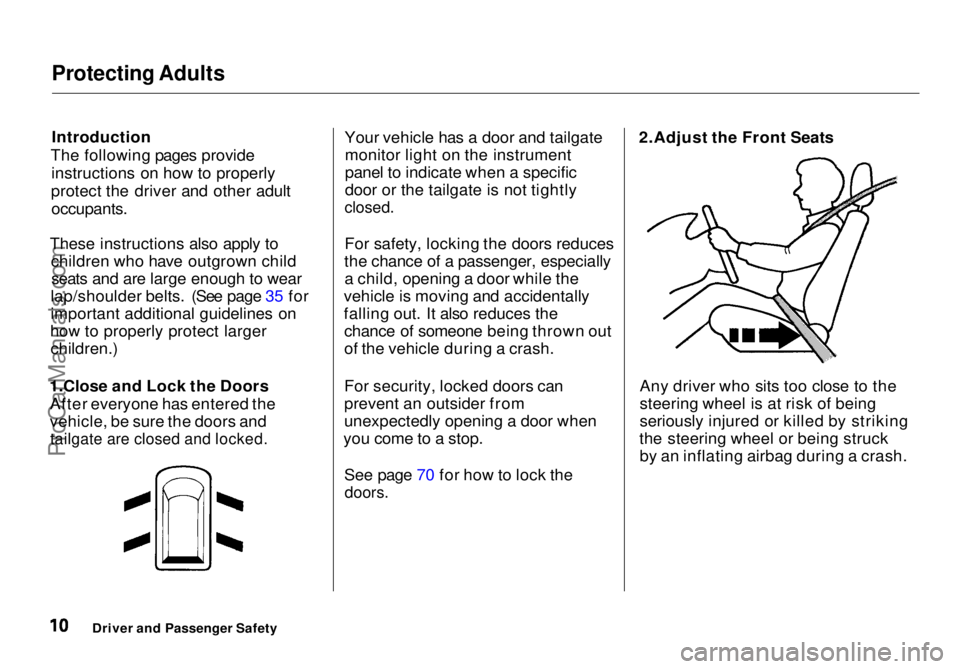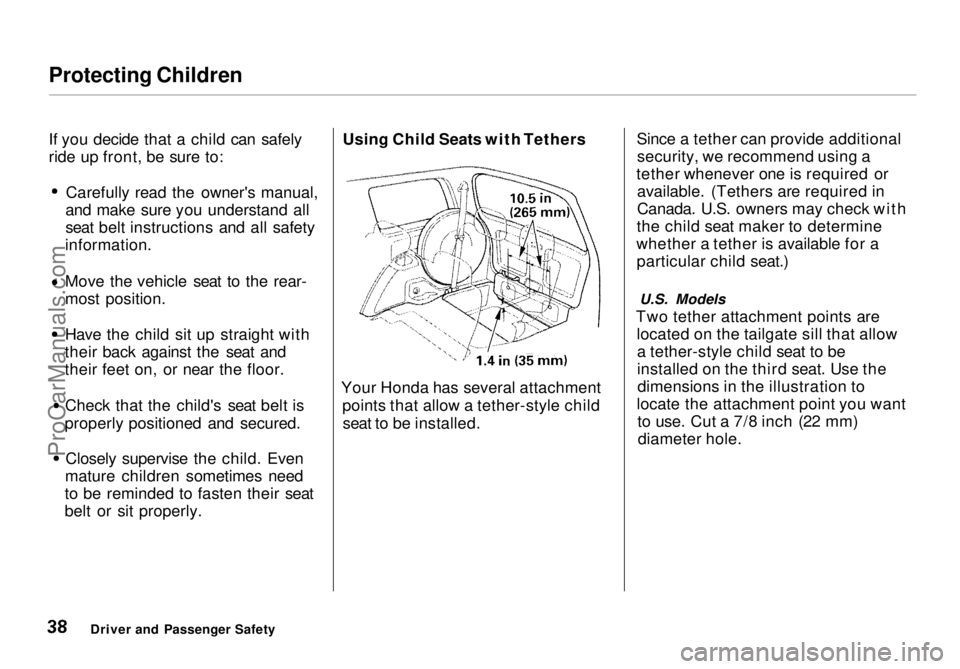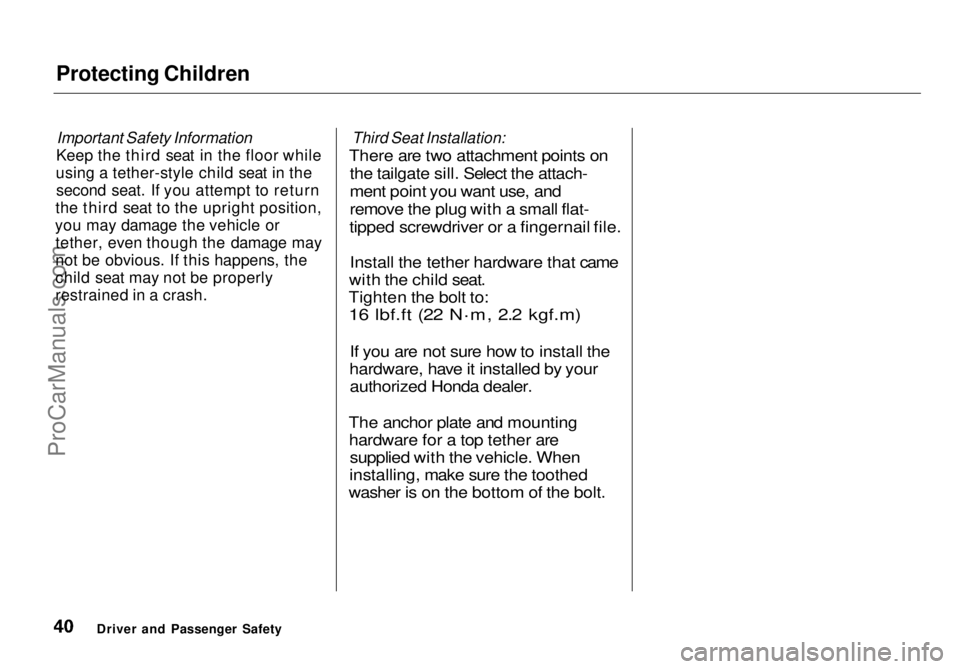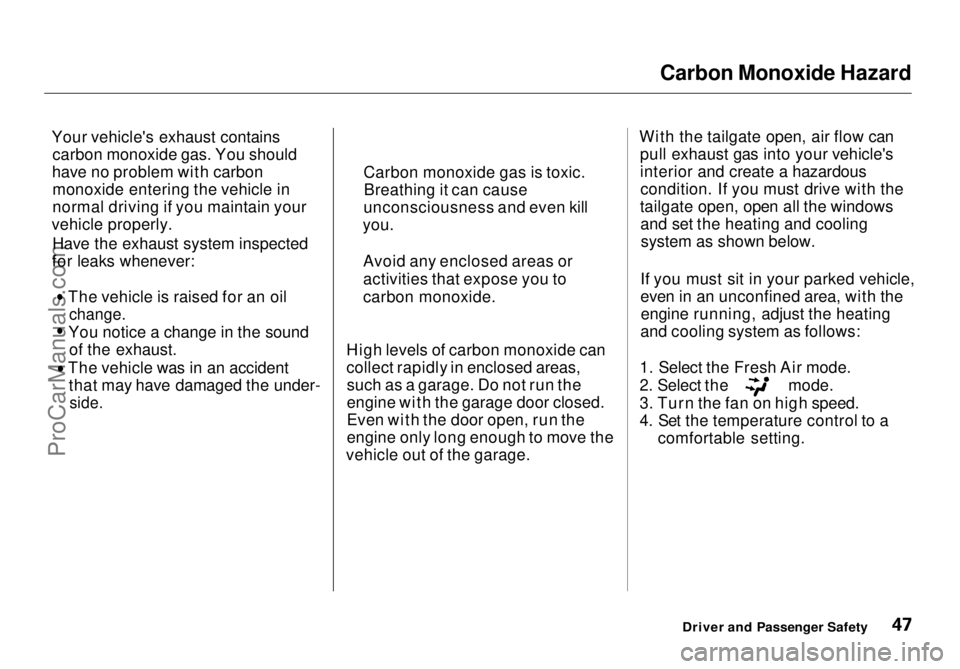1998 HONDA ODYSSEY tailgate
[x] Cancel search: tailgatePage 10 of 272

Your Vehicle's Safety Features
Door Locks
Keeping your doors locked reduces
the chance of being thrown out of
the vehicle during a crash. It also
helps prevent occupants from accidentally opening a door and
falling out, and outsiders from unexpectedly opening your doors.
Pre-Drive Safety Checklist
To make sure you and your passengers get the maximum
protection from your vehicle's safety
features, check the following each
time before you drive away: All adults, and children who have
outgrown child safety seats, are
wearing their seat belts and
wearing them properly (see page
13).
Any infant or small child is
properly restrained in a child seat
in a back seat (see page 19 ). Front seat occupants are sitting as
far back as possible from the steering wheel and dashboard (see page 10). Seat-backs are upright (see page
11).
Head restraints are properly
adjusted (see page 12 ). All doors and the tailgate are
closed and locked (see page 10). All cargo is properly stored or
secured (see page 136).
The rest of this section gives more detailed information about how you
can maximize your safety.
Remember, however, that no safety system can prevent all injuries ordeaths that can occur in severe
crashes, even when seat belts are
properly worn and the airbags deploy.
Driver and Passenger SafetyProCarManuals.comMain Menu Table of Contents s t
Page 11 of 272

Protecting Adults
Introduction
The following pages provide instructions on how to properly
protect the driver and other adult
occupants.
These instructions also apply to children who have outgrown childseats and are large enough to wear
lap/shoulder belts. (See page 35 for
important additional guidelines on
how to properly protect larger children.)
1.Close and Lock the Doors After everyone has entered the
vehicle, be sure the doors and
tailgate are closed and locked.
Your vehicle has a door and tailgate
monitor light on the instrument
panel to indicate when a specific
door or the tailgate is not tightly
closed.
For safety, locking the doors reduces
the chance of a passenger, especially a child, opening a door while the
vehicle is moving and accidentally
falling out. It also reduces the chance of someone being thrown out
of the vehicle during a crash.
For security, locked doors can
prevent an outsider from
unexpectedly opening a door when
you come to a stop.
See page 70 for how to lock the
doors.
2.Adjust the Front Seats
Any driver who sits too close to thesteering wheel is at risk of being
seriously injured or killed by striking
the steering wheel or being struck by an inflating airbag during a crash.
Driver and Passenger SafetyProCarManuals.comMain Menu Table of Contents s t
Page 39 of 272

Protecting Children
If you decide that a child can safely
ride up front, be sure to:
Carefully read the owner's manual,
and make sure you understand all
seat belt instructions and all safety
information. Move the vehicle seat to the rear-
most position.
Have the child sit up straight with
their back against the seat and
their feet on, or near the floor. Check that the child's seat belt is
properly positioned and secured.
Closely supervise the child. Even
mature children sometimes need
to be reminded to fasten their seat
belt or sit properly. Using Child Seats with Tethers
Your Honda has several attachment points that allow a tether-style childseat to be installed. Since a tether can provide additional
security, we recommend using a
tether whenever one is required or available. (Tethers are required in
Canada. U.S. owners may check with
the child seat maker to determine
whether a tether is available for a particular child seat.)
U.S. Models
Two tether attachment points are located on the tailgate sill that allowa tether-style child seat to be
installed on the third seat. Use thedimensions in the illustration to
locate the attachment point you want to use. Cut a 7/8 inch (22 mm)diameter hole.
Driver and Passenger SafetyProCarManuals.comMain Menu Table of Contents s t
Page 41 of 272

Protecting Children
Important Safety Information
Keep the third seat in the floor while
using a tether-style child seat in the second seat. If you attempt to return
the third seat to the upright position,
you may damage the vehicle or tether, even though the damage may
not be obvious. If this happens, the
child seat may not be properly
restrained in a crash.
Third Seat Installation:
There are two attachment points on the tailgate sill. Select the attach-
ment point you want use, and
remove the plug with a small flat-
tipped screwdriver or a fingernail file.
Install the tether hardware that came
with the child seat.
Tighten the bolt to:16 lbf.ft (22 N .
m, 2.2 kgf.m)
If you are not sure how to install the
hardware, have it installed by your authorized Honda dealer.
The anchor plate and mounting hardware for a top tether are supplied with the vehicle. When
installing, make sure the toothed
washer is on the bottom of the bolt.
Driver and Passenger Safety
ProCarManuals.comMain Menu Table of Contents s t
Page 48 of 272

Carbon Monoxide Hazard
Your vehicle's exhaust contains carbon monoxide gas. You should
have no problem with carbon monoxide entering the vehicle in
normal driving if you maintain your
vehicle properly.
Have the exhaust system inspected
for leaks whenever: The vehicle is raised for an oil
change.
You notice a change in the sound
of the exhaust. The vehicle was in an accident
that may have damaged the under-
side.
High levels of carbon monoxide can
collect rapidly in enclosed areas,
such as a garage. Do not run the
engine with the garage door closed.
Even with the door open, run the
engine only long enough to move the
vehicle out of the garage. With the tailgate open, air flow can
pull exhaust gas into your vehicle's
interior and create a hazardouscondition. If you must drive with the
tailgate open, open all the windows and set the heating and coolingsystem as shown below.
If you must sit in your parked vehicle,
even in an unconfined area, with the engine running, adjust the heating
and cooling system as follows:
1. Select the Fresh Air mode. 2. Select the mode.
3. Turn the fan on high speed.
4. Set the temperature control to a
comfortable setting.
Driver and Passenger Safety
Carbon monoxide gas is toxic.
Breathing it can cause
unconsciousness and even kill
you.
Avoid any enclosed areas or
activities that expose you to
carbon monoxide.ProCarManuals.comMain Menu Table of Contents s t
Page 50 of 272

Instruments and Controls
This section gives information about
the controls and displays thatcontribute to the daily operation of
your Honda. All the essential
controls are within easy reach.
Control Locations............................ 50
Indicator Lights................................ 51
Gauges.............................................. 54
Tachometer.................................. 54
Trip Meter.................................... 54
Speedometer................................ 55
Odometer...................................... 55
Temperature Gauge.................... 55
Fuel Gauge................................... 55
Maintenance Required
Indicator.................................... 56
Controls Near the Steering
Wheel........................................ 57
Headlights.................................... 58
Daytime Running Lights............. 58
Instrument Panel Brightness..... 59
Turn Signals................................. 59
Windshield Wipers...................... 60
Windshield Washers................... 61
Rear Window Wiper and
Washer...................................... 61
Hazard Warning........................... 61
Rear Window Defogger.............. 62
Steering Wheel Adjustment....... 62
Steering Wheel Controls ................ 64
Cruise Control.............................. 64
Keys and Locks................................ 67
Keys............................................... 67
Immobilizer System..................... 68
Ignition Switch............................. 69
Power Door Locks....................... 70
Remote Transmitter.................... 71
Childproof Door Locks............... 72
Tailgate......................................... 72
Glove Box..................................... 73
Seats.................................................. 74
Passenger Seating....................... 74
Seat Adjustments......................... 74
Driver's Seat Power Height
Adjustment............................... 75
Armrests....................................... 76
Head Restraints........................... 76
Third Seat Access........................ 77
Removing the Second Seats
in the Six-Passenger Model.... 78
Folding the Second Seats
in the Seven-Passenger
Model.................................... 78
Reclining the Second Seat.......... 79
Folding the Third Seat
in All Models............................ 80
Power Windows............................... 82
Sunroof.............................................. 83
Mirrors.............................................. 84
Adjusting the Power Mirrors..... 84
Parking Brake.................................. 85
Digital Clock..................................... 86 Beverage Holder.............................. 86
Dashboard Compartment............... 88
Center Pocket.................................. 88
Vanity Mirror................................... 88
Cigarette Lighter............................. 89
Ashtrays............................................ 89 Interior Lights.................................. 90
Ceiling Lights............................... 90
Spotlights...................................... 90
Tailgate Light............................... 91 Courtesy Lights........................... 91
Instruments and ControlsProCarManuals.comMain Menu s t
Page 54 of 272

Indicator Lights
U.S.
Anti-lock Brake System
(ABS) Indicator
This light normally comes on when you turn the ignition switch ON (II) and goes off after the engine starts.
If it comes on at any other time,
there is a problem in the ABS. If this
happens, take the vehicle to your dealer to have it checked. With the
light on, your vehicle still has normal
braking ability but no anti-lock. Turn Signal and
Hazard Warning
Indicators
The left or right turn signal light blinks when you signal a lane changeor turn. If the light does not blink or
blinks rapidly, it usually means one of the turn signal bulbs is burned out (see page 207). Replace the bulb as
soon as possible, since other drivers
cannot see that you are signalling.
When you turn on the Hazard
Warning switch, both turn signal lights blink. All turn signals on theoutside of the vehicle should flash. Door and Brake Lamp Monitor
The appropriate light comes on in this display if the tailgate or any dooris not closed tightly. If a brake lightdoes not work, the BRAKE LAMP
indicator comes on when you push
the brake pedal with the ignition switch ON (II).
A burned out brake light is a hazard when drivers behind you cannot tell
you are braking. Have your brakelights repaired right away.
All the lights in the monitor display come on for a few seconds when you
turn the ignition switch ON (II).
Instruments and Controls
BRAKE LAMP
INDICATOR
ABS
CanadaProCarManuals.comMain Menu Table of Contents s t
Page 68 of 272

Keys and Locks
Keys
Your vehicle comes with two kinds of keys: a master key and a valet key.
The master key fits all locks on your
vehicle:
Ignition
Doors
Glove box
Tailgate
The valet key works only in the
ignition and the door locks. You can
keep the glove box locked when you
leave your vehicle and valet key at a parking facility.
You should have received a key number plate with your keys. You
will need this key number if you ever have to get a lost key replaced. Keep
the plate stored in a safe place. If you
need to replace a key, use only
Honda-approved key blanks.
These keys contain electronic circuits that arc activated by theImmobilizer System. They will not
work to start the engine if the circuits are damaged. Protect the keys from direct
sunlight, high temperature, and
high humidity. Do not drop the keys or set heavy
objects on them. Keep the keys away from liquids.
If they get wet, dry them immedi-
ately with a soft cloth.
The keys do not contain batteries. Do not try to take them apart.
Remote Transmitter
Some models also come with two
remote transmitters; see page 71 for
an explanation of the operation.
Instruments and Controls
KEY
NUMBER
PLATE
MASTER
KEY
(BLACK)
VALET KEY
(GRAY)ProCarManuals.comMain Menu Table of Contents s t